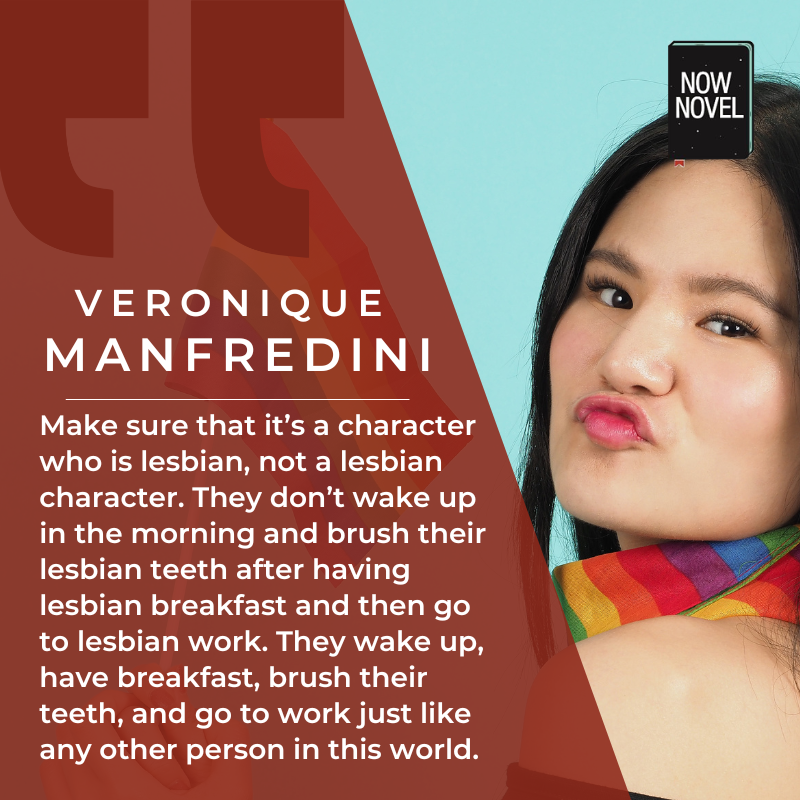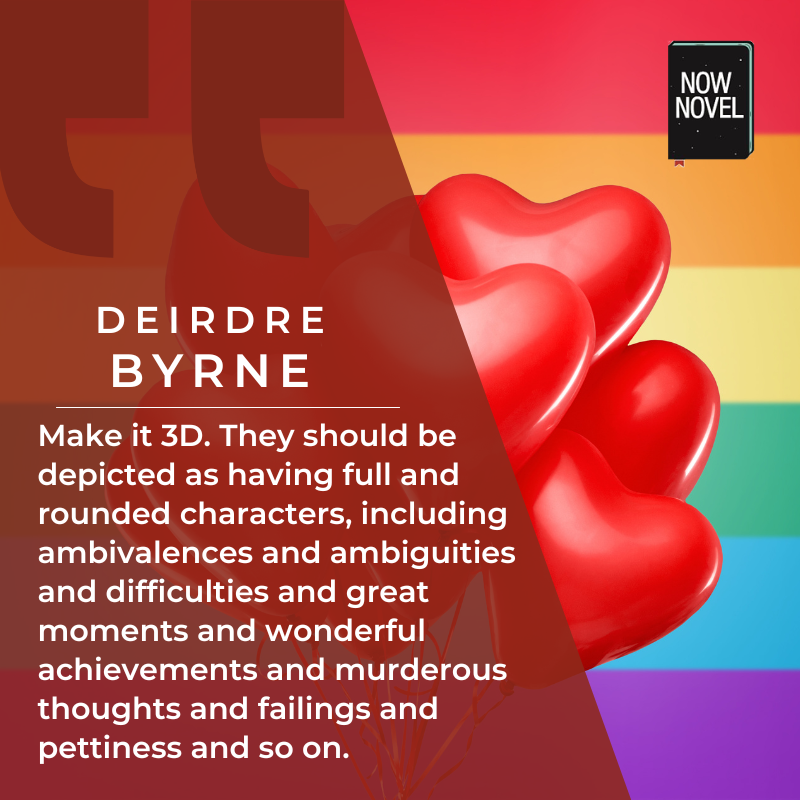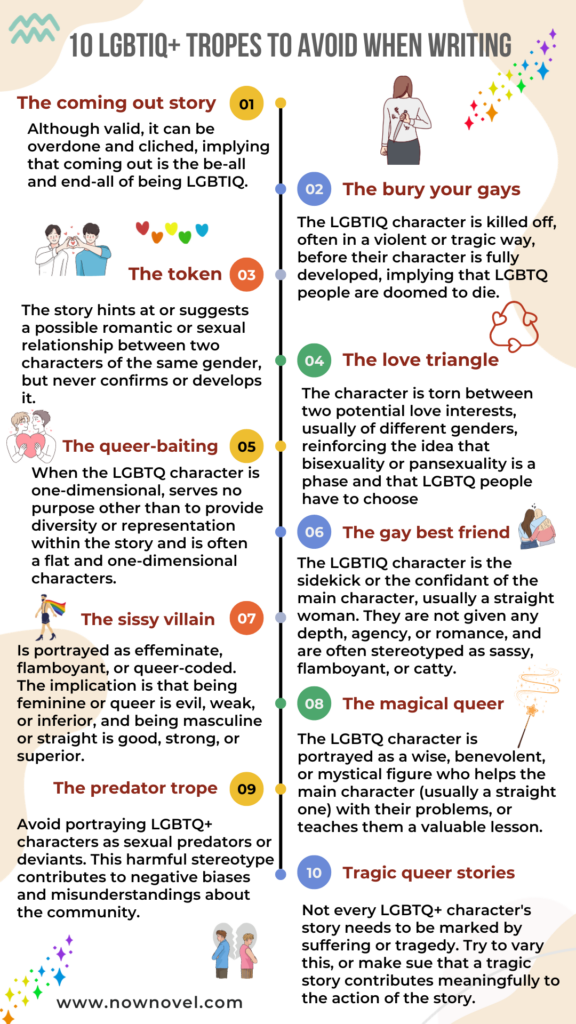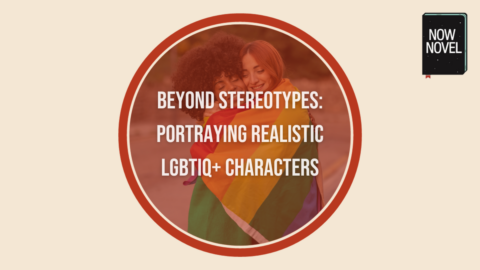Getting beyond the stereotypes and writing credible, relatable LGBTIQ+ characters is possible. You might want to do some research, if you don’t identify as queer, and you will want to avoid the tropes mentioned below.
The first kiss
Back in 1991, the popular TV legal drama, LA Law was in the news. The reason was that it was going to be showing the first lesbian kiss on prime-time TV. This was huge. The hype before the episode was shown is unbelievable by today’s standards. There were newspaper stories written about it and so much publicity was generated.
The kiss was between lesbian CJ Lamb (played by Amanda Donohoe) and Abby Perkins (Michele Greene). But that’s all it was in the end: a single kiss. CJ Lamb was written out of the series and Abby ended up with a man. Greene later revealed it was all a publicity stunt. It feels so very quaint, now, to recall the hype, when more and more TV series and novels have relatable and credible LGBTIQ+ characters, and they do more than simply kiss once.
A brief history
We’ve come a long way from Oscar Wilde being jailed for homosexual acts, and the tragedy that was implicit in the lesbian classic, Radclyffe Hall ’s The Well of Loneliness, from the title alone. Yet for many years this was the only novel that openly depicted lesbian desire and lives.
Then there is Maurice by E.M Forster: this is a tale of gay love in early 20th century England, and although the first version was written in 1913, and went through various revisions, it was published posthumously only in 1971.
In the 1950s lesbian pulp fiction depicted lesbian lives, although with often tragic endings, or with women ending up with men. This did change with Ann Bannon’s series of novels that had happier endings. Around the same time Mary Renault (who was lesbian) started writing her series of novels set in ancient Greece and featuring male same-sex relationships. Then there was Christopher Isherwood’s A Single Man. When it appeared in 1962, it shocked many people with its frank and sympathetic portrait of a middle-aged gay man.
But moving on from historical records of queer-themed literature, the question remains as to how to write authentic, believable and relatable LGBTIQ+ characters that are more than cardboard cut-outs or stereotypes.
And why include them anyway? With estimates that LGBTIQ+ identifying people make up as much as 10% of any population, it makes sense that to create believable fiction, you might want to include such characters, or that they might be central to your plotline. Let’s look at some of the considerations to take into account when writing credible LGBTIQ+ characters.

Can straight people write queer?
Firstly, can straight people create LGBTIQ+ characters? To get some perspective on the matter, three writers who identify as queer give their opinions.
Writer and Now Novel coach, Nerine Dorman says, “I’m fine with it. Just as I’m fine with queer folks writing straight characters. This notion that you can only write what you personally know is rubbish. So long as you do your utmost to avoid hackneyed stereotypes, you’ll be gold. And if in doubt, get someone who is part of the LGBTIQ+ community to read your work and let you know if you’re missing the mark.”
Writer Kayleigh Gallagher is of the opinion that, “I don’t necessarily believe you have to be LGBTQ to write about LGBTQ characters in a respectful manner. In many ways you’d approach it the same way you would approach any subject you don’t yet have a full understanding of.”
Professor of English Literature and a former head of the University of South Africa’s Gender Studies Institute, Deirdre C. Byrne is of the opinion: “To say straight people can’t write LGBTIQ+ characters is a dangerous form of identity politics. If that were the case, if we take it to its logical extreme, then I can only write about myself. Let alone that about two lesbians on an extraterrestrial planet, because I’m not living on an extraterrestrial planet. It means then that I could only write about my own life. Then the only form of authentic writing would be autobiography. So I’m not at all opposed to heterosexual people writing about LGBTIQ+ our people, and I’m not opposed to men writing about women, but as long as they don’t dominate. I mean, if all of the LGBTQI fiction was being written by heterosexual people, there would be a problem with the silencing of LGBTQI voices.”
BECOME A DAB HAND AT CHARACTER DESCRIPTION BASICS
Get a detailed guide to character description with exercises and videos and create a relatable cast.
Get your guide
Do the research
If you do not identify as LGBTIQ+, and cannot write from the outside in, as it were, do your research. If you’re writing in a particular time period, you will need to look how closeted LGBTIQ+ people were in a particular time period: consider how many some Native American cultures regarded intersex, androgynous people as being blessed.
But this extends to researching a particular milieu: reading up or going to gay clubs for instance, speaking to LGBTIQ+ organisations, reading online magazines such as Curve magazine or them. Learn about the history, culture, and experiences of LGBTIQ+ people from various sources, such as books, articles, documentaries, podcasts and so on. Have a look at the Making Gay History podcast, for example. Look at the issues face as well, the terminology or language they use.
Gallagher has the following advice for researching:
In many ways you’d approach it the same way you would approach any subject you don’t yet have a full understanding of. You research, and you talk to people. I’m not from Brooklyn and I don’t spend a lot of time there, but if I wanted to write a story set in Brooklyn, I’d look at maps, read about local spots and their history, maybe visit and talk to some people to get their perspective. And then, when I sat down to write, I’d treat the characters in that setting with the same respect as I would grant to any other character in any other setting.
Writer and Now Novel coach, Dorman: “Firstly, if you have queer friends, listen to them. Hear their stories. Try to understand the issues they face. Then, read as much literature written by queer folk as you can lay hands on.”
Make them 3D
The first piece of advice on writing character comes from Byrne:
Make it 3D. LGBTIQ+ characters are literally just the same as every other character, except for the sexual orientation and gender expression. They should be depicted as having full and rounded characters, including ambivalences and ambiguities and difficulties and great moments and wonderful achievements and murderous thoughts and failings and pettiness, and so on.
Give them a backstory, motivations, a lesson to learn by the end of the story, how they grow and change, traits, goals, how they cope with life’s challenges, or they don’t, and other aspects of their identity.
Writer Emma Donoghue has an interesting tactic for making people interested in her characters before revealing that they are same sex: “I’ve noticed that a few of my books, for instance, I delay the knowledge of the same-sex love story to a point when the readers should be fond of these characters already.”
Another important point is not to make everything about them about their sexual identity. Just as you wouldn’t write a heterosexual character by hammering home that they are heterosexual, try to weave in the fact that they are LGBTIQ+. It is part of who they are, it is not their entire identity.

Veronique Manfredini, in her discussion of how to write characters, puts it well and wittily:
Being LGBTQ+ is NOT a personality trait. I’ll never say it enough times, being gay is not all the character is, just like being straight isn’t all you are. So if you want to write a character that likes girls, make sure that it’s a character who is lesbian, not a lesbian character. They don’t wake up in the morning and brush their lesbian teeth after having lesbian breakfast and then go to lesbian work. They wake up, have breakfast, brush their teeth, and go to work just like any other person in this world.
Meanwhile writer Michael Cunningham echoes this view when talking about writing gay characters:
I didn’t want the gay aspects of my books to be perceived as their single, primary characteristic. Like any halfway serious writer, I’m trying to write about more than my characters’ outward qualities, and focus on the depths of their beings, their fears and their devotions, which take place at a level deeper than sexual orientation. Gay people fall in and out of love, for instance, in ways that are not entirely foreign to the ways in which straight people do. There are of course some real differences in the ways gay people live and what we experience, but we’re not from Mars.
Let’s look at how this plays out in some novels.
For example, in The Color Purple, by Alice Walker, the main protagonist, Celie, falls into a relationship with Shug Avery, a nightclub singer and the mistress of Celie’s husband, Mister. The way this relationship is introduced and handled is almost incidental to the narrative, it is, instead a fact of the story. However, it was so “incidental” that the 1983 film of the novel omitted these lesbian overtones (but we’re talking of a different time here).
Emma Donoghue’s Landing is about the relationship between Dubliner, Sile, a flight attendant, and Jude, a Canadian archivist who does not want to leave her town in Ontario. The book is not so much about their lesbian identities as about how to reconcile the differences of a trans-Atlantic relationship, about emigration and about how much a person is prepared to give up for love.
Meanwhile, in Less by Andrew Sean Greer we follow a middle-aged gay writer, Arthur, who travels around the world to avoid attending his ex-boyfriend’s wedding. It’s a rip-roaring rollercoaster of a novel about ageing, acceptance, romantic love and travel. Arthur just happens to be LGBTQ+, the novel is so much more than that.
On the writing process
For a closer look at process and incorporating LGBTIQ+ themes and characters in fiction, here’s a look at how Dorman and Gallagher approach their own writing of fiction.
Dorman says:
Many, many years ago, I wrote my first novel, Khepera Rising, and I knew that my main character, Jamie, had to be unapologetically bi. Later on, with my Those Who Return duology, things got even more interesting, with characters reincarnating into the bodies of the sex they did not identify as – so this opened up a whole fresh dimension for me to play with, asking questions of “How does a nominally straight woman feel about now being male, and how does she navigate this new existence?”
I’m really big on normalising queerness in writing. If I think back to authors who changed how I view these matters, I look at writers like Anne McCaffrey and Mercedes Lackey, who had queer characters in their stories in such a way that it was never seen as a big deal. Other characters simply accepted them for who they were.
I include queer characters because queer folk are part of my friendship circles.
And it is my hope that queer folk who have yet to come out might read my stories and resonate with them, and know that it’s fine to be who you are. I know these stories helped me.
Gallagher says:
Most, if not all of my fiction, includes LGBTQ characters. Not for a particular reason, I don’t think; a lot of the themes in my works just translate well to a queer perspective. Much of Radio Apocalypse, for example, was an exploration of how isolating it can be to come to terms with one’s identity. Often this isn’t intentional. The stories I tell are, in some respect, my stories—stories about me—and it’s difficult to divorce the experiences I had in my formative years from my developing identity at the time.
Writer Val McDermid wrote straight-themed thrillers until, she says, she got famous enough to write a gay-themed book. Her character Lindsay Gordon is a freelance journalist and investigator who, in the opening pages of Report for Murder (1987), describes herself as “a cynical socialist lesbian feminist.” McDermid’s reasons for doing so are enumerated below:
I wrote a lesbian heroine because I’d grown up in a time and place where there were no templates for the life I wanted to live. The queer struggle for self-definition has been pursued in no small part so that the next generation has a springboard for imagining how to live. Every literary movement requires pioneers to kick open the door a crack. Others spot the opening and push the door wider. Then, at last, there’s room for everyone to walk through and write the lives they want to write.
He/she/they/them – know your pronouns
Since the Covid pandemic, we are used to having meetings on Zoom and Teams and other platforms. And when you are signing in and witing your name you can also include what pronouns to use, and it’s made us all so much more aware of what pronouns we prefer to use.
Pronouns are another important point to consider: some LGBTIQ+ people use the pronoun “them” to indicate that they are non-binary. Think carefully about how your character introduces themselves. Be mindful of any name changes that may occur during a character’s journey of self-discovery, for example when a trans person leaves their “dead name” behind and takes on a new name. Misgendering can be hurtful and offensive, so pay careful attention to this detail. Adding this will not only show your sensitivity and understanding, but will also make your portrayal that much more authentic.
WRITE WITH A COACH
Need some help with crafting your story and creating 3D characters? Sign up with a coach today
Learn more >Have a laugh and don’t forget the funnies
Byrne brings up another important point to remember: don’t forget the funnies. Naming Torch Song Trilogy as one of her favorite LGBTIQ+-themed book and movies, she says that “the humor is very very sharp and slick and it’s thoroughly enjoyable. In LGBT in writing with LGBTIQ+ characters tends to all be deadly serious, and that’s a limitation on what LGBTIQ+ characters can do, because some of us can also tell jokes.”
For a complete guide to writing character, have a look at our comprehensive post.

10 tropes and how to avoid them
When writing LGBTQ+ it’s also important to be aware of a number of story and character tropes, and how to avoid them. Here are 10 pitfalls to watch out for.
1. The coming-out story
Although valid, it can be overdone and clichéd, implying that coming out is the be-all and end-all of being LGBTIQ+. Avoid this by not highlighting this aspect, unless it’s part of the story. Show other parts of their personality, show the depth of their characters.
2. The bury your gays
The LGBTIQ+ character is killed off, often in a violent or tragic way, before their character is fully developed, implying that LGBTQ+ people are doomed to die. Make sure their death is integral to the plot and storyline, and that their character is well developed. 3.
3. The token
This is when the LGBTQ+ character is one-dimensional, serves no purpose other than to provide diversity or representation within the story. The character is there to ‘fill a quota’. Ugh. To avoid this make sure that they have a meaningful role to play in the story, with goals, a backstory, relationships and so on.
4. The love triangle
The character is torn between two potential love interests, usually of different genders, reinforcing the idea that bisexuality or pansexuality is a phase and that LGBTQ+ people have to choose one or the other. While this can be a meaningful addition to a character’s story arc, it can play into stereotypes. Avoid this by making sure the character’s love interests are fully developed and realistic.
5. The queer-baiting
The story hints at or suggests a possible romantic or sexual relationship between two characters of the same gender, but never confirms or develops it. This can be extremely frustrating to watch or read, and is sometimes used as a marketing strategy, as in the example with the LA Law kiss. Try to avoid doing this, unless it’s somehow integral to the plot.
6. The gay best friend
The LGBTIQ+ character is the sidekick or the confidant of the main character, usually a straight woman. They are often just props, and are not given any depth, agency, or romance, and are often stereotyped as sassy, flamboyant, or catty. To avoid this, give them some depth beyond their friendship with the main character.
7. The sissy villain
The villain portrayed as effeminate, flamboyant, or queer-coded. The implication is that that being feminine or queer is evil, weak, or inferior, and that being masculine or straight is good, strong, or superior. Rather create a more nuanced villain. Even villains need backstory and some shades of gray.
8. The magical queer
The LGBTQ+ character is portrayed as a wise, benevolent, or mystical figure who helps the main character (usually a straight one) with their problems, or teaches them a valuable lesson. Well, LGBTQ+ characters have lives, and faults and failings and are not necessarily imbued with wisdom just because they are not heterosexual. Such characters can appear sappy. By all means give them some wise powers, but show their faults, too.
9. The predator trope
Avoid portraying LGBTQ+ characters as sexual predators or deviants without explanation. This harmful stereotype contributes to negative biases and misunderstandings about the community. Of course, there are predators out there, of every sex and identity, but again, if you’re going to have such a character give them some depth and some credible motivations.
10. Tragic queer stories
Not every LGBTQ+ character’s story needs to be marked by suffering or tragedy. Add some humor, too. Make sure that a tragic story contributes meaningfully to the action of the story. This stereotype can reinforce the idea that queer people’s lives are only marked by tragedy and doom.
For more information on writing realistic characters, not caricatures, have a look at our post which details effective character description examples from a range of authors from Victorian to modern times. Read up on how important it is to profile your characters, too.
- Follow Nerine Dorman on Instagram at @nerinedorman
- Follow Kayleigh Gallagher on Instagram at @so_many_ocs
- Follow Deirdre Byrne on Instagram at @deirdrebyrne_literature



2 replies on “Beyond stereotypes: portraying realistic LGBTIQ+ characters”
This is great! Just a note: it is “trans person” not “transperson”; “trans woman” not “transwoman”, etc. A person’s transness does not define their personhood, womanhood or manhood. This also avoids the common pitfall that, for example, trans women are a different category of women.
I would also add that when writing trans characters, it is very important to read literature about transness by trans people and not just use Wiki or cisgender writers‘ representations. Comparatively, trans narratives are less rounded and less understood by mainstream media and cisgender authors than other queer characters are. The same could be said for pansexuality and bisexuality, in terms of reading authors who are pan and bi.
Dear Gabriel,
Thanks so much for writing in and pointing this out. I have changed this on the blog.
And you make some excellent points in regard to trans characters and narratives, and that writers attempting these narratives should read more broadly and work by trans people. Thanks too for noting this.